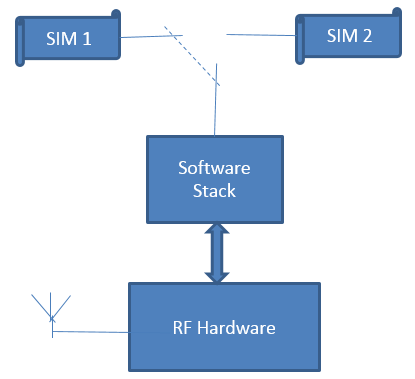Summary
Public safety works across a diverse geographic environment. Even with a high availability of the Long Term Evolution (LTE) radio access network (RAN) provided by FirstNet, there may be locations in the United States that lack coverage but are still served by commercial LTE providers. In these instances, it is critical that LTE devices used by public safety have the capability to switch to a commercial LTE RAN. The Public Safety Communications Research (PSCR) program is researching and analyzing the technical switching methods as well as the current and future mobile devices that can support this capability.
Description

Dual SIM solution for inter-network mobility.
The Middle Class Tax Relief and Job Creation Act of 2012 (H.R. 3630) appropriated $7 billion for the establishment of a nationwide interoperable public safety broadband network under FirstNet, an independent authority in the National Telecommunications and Information Administration (NTIA). FirstNet will provide first responders with dedicated and prioritized access to high-speed data, voice, and other mission critical applications. This nationwide network will enable public safety agencies at the federal, state, and local levels to effectively conduct their mission by establishing a common communications system based on 3GPP LTE standards. PSCR, a joint NIST/NTIA program, is sponsored by FirstNet to analyze and measure the capability of mobile devices to switch to a commercial LTE RAN when FirstNet RAN coverage is unavailable.
AN INNOVATIVE APPROACH
PSCR has diverse expertise in telecommunications, including LTE air interface, mobility management, and mobile devices. Additionally, PSCR has multiple cooperative research and development agreement (CRADA) partners in the mobile devices industry.
PSCR’s primary focus area on this task is the behavior of mobile device switching between the Band 14 FirstNet RAN and commercial LTE RAN. The secondary focus is on mobile device switching between the Band 14 FirstNet RAN and Wi-Fi networks. Measurements and analysis will be performed with commercially available as well as internally developed tools and methods. PSCR will conduct a quantitative analysis of performance of inter-network mobility of Band 14 LTE user devices. The goals of the project are to:
- Evaluate the features of existing mobile devices that are capable of multi-SIM/multi-band operation between FirstNet and commercial networks
- Measure parameters that show the data service interruption time when switching between FirstNet and commercial LTE networks or Wi-Fi
- Evaluate the impact of network switching on applications used by public safety today
- Determine the effect of switching from FirstNet to a commercial RAN on Quality of Service, Priority, and Pre-emption (QPP) policy and function
- Evaluate the impact on mobile device security when switching from FirstNet to commercial LTE networks or Wi-Fi
VALUE TO PUBLIC SAFETY
When public safety network coverage is unavailable in LTE Band 14, user devices will be rendered useless without alternative network access. Given the wide geographic deployment level of commercial LTE providers and Wi-Fi, multi-band and multi-service devices capable of switching between FirstNet and commercial networks will provide first responders with a higher probability of service. Understanding the capabilities, limitations, and performance of mobile devices moving between networks will enable FirstNet to provide first responders with maximized service coverage.

